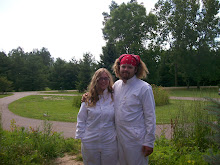



Here are some pictures of our brand new (to us, this theory was developed in the 1600's from the natural round skeps commonly used for "primitive beekeeping") hive body. It is known as the warre hive, named for its creator Abbe Emile Warre. The hive design is a hexagon, and the idea behind it is to maximize the bees space and allow them to draw and fill comb to their specific desire, but to also recreate a more natural environment for them. Remember that bees have existed for millions of year, evolving throughout time, but still desiring the shelter of an old, hollow tree to that of a commercial beekeepers hive body. The Warre hive eliminates pockets of heat and draft that can occur in a naturally oblong structure. When you think of the bees and their ability to cluster and stay warm in the frigid Michigan winters, part of their survival is related to their heat retention. Bees do not hibernate during the winter; they cluster into a ball and keep the queen in the middle nestled at around 93 degrees. Throughout the winter depending on the frigidity of the weather, the bees will contract and expand in the hive to cover combs filled with their winter stores of honey. Should there be too many cold days during a particular winter and it is not uncommon to see entire colonies that have starved to death mere inches from nourishing honey stores. If it is too cold for the bees to expand and cross the comb to, say the other corner of the hive, then they risk starving to death, not freezing to death. The principle of the Warre hive plays on that design. A hexagon is a geometric shape that has equivalent angles and compliments, but not specific corners. Using that principle, the colony has a better chance of retaining their nest scent and heat so they might never lost the ability to cover the comb they worked so hard to fill and cap during those hot summer days. Above is the link where we discovered information and photo's of the hives original design, and there are some pictures of our first established Warre hive.
We constructed the hive out of leftover lumber, 2 x 4's and a late-season feral swarm that took off from one of our four hives at Keith's parents house. Nectar flow is slowing right around now, even though some plants are sill producing pollen, it is only half the nutrition the bees need to create honey and survive. Typically swarms that form this late in the season do not survive. There is not adequate time for the bees to build comb, fill it with nectar and pollen and then store and cap the honey. There is also brood to be laid, workers will need to survive throughout the winter to keep the colony orderly and clean through the harsh winters.
This is the first hive we have attempted. We have been feeding them sugar syrup and they have established some comb with nectar, so we have a chance they could survive, but probably because we will be over-wintering them indoors to limit the stress on the bees.
It's true that we do want the fittest of our colonies to survive, but it doesn't mean we can't try some new approaches to make happy, healthy bees!





No comments:
Post a Comment